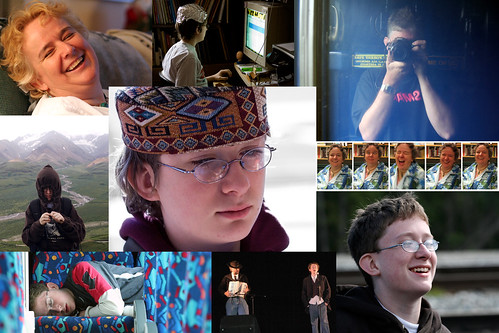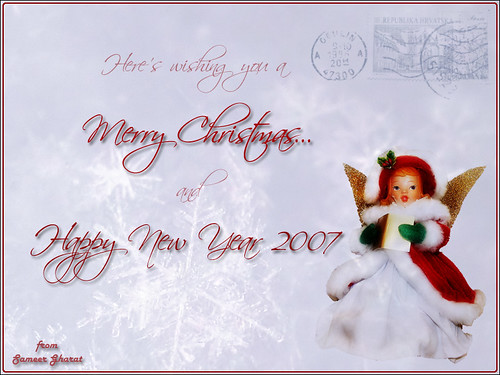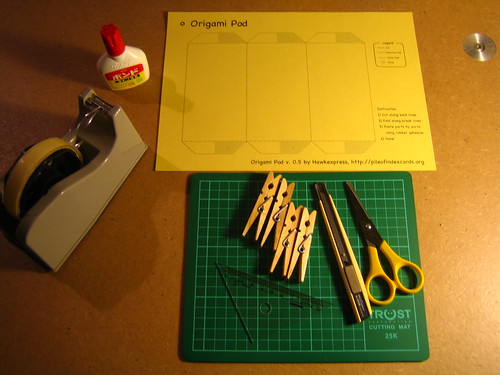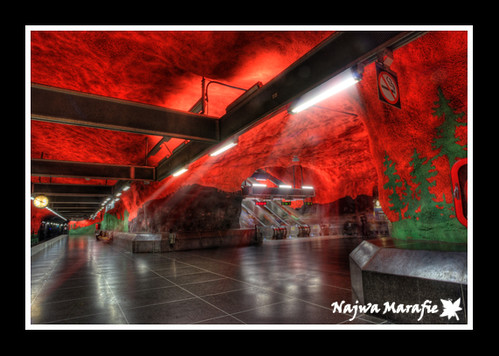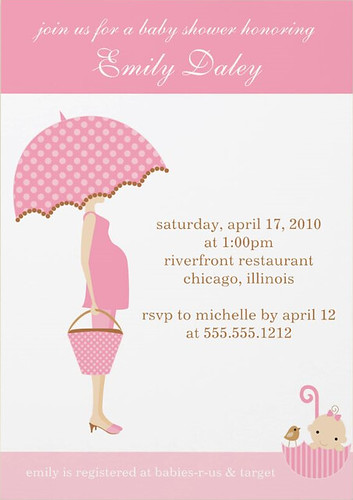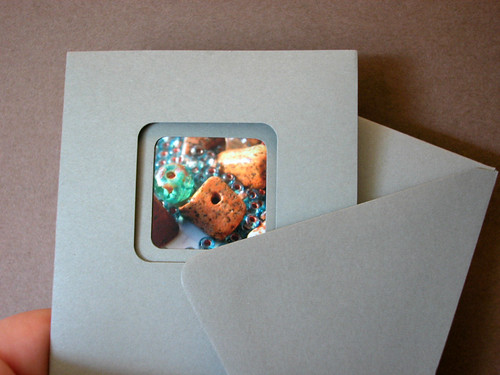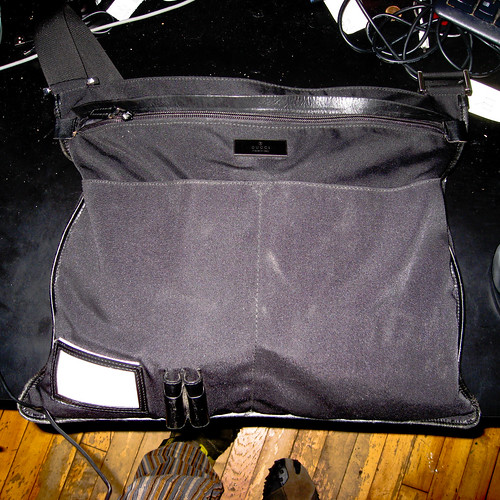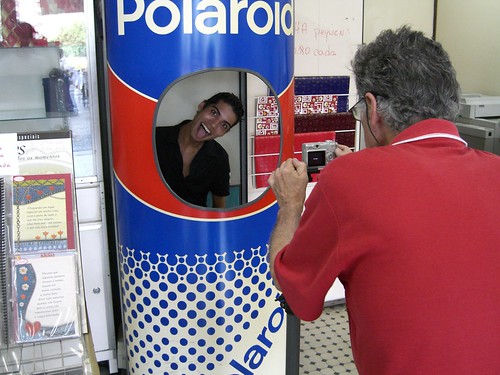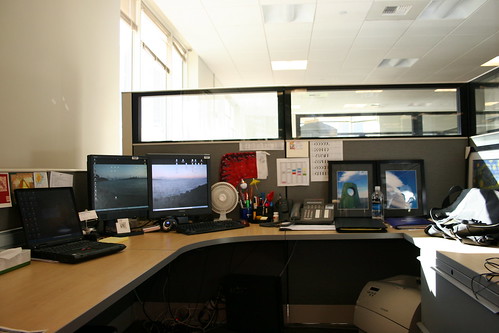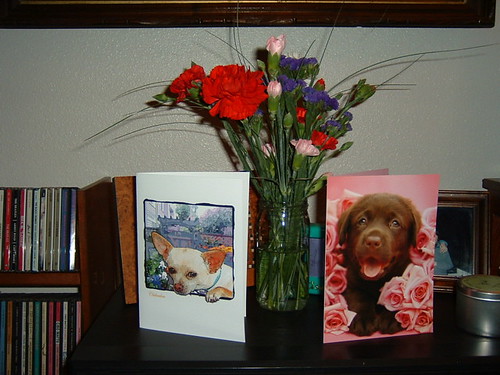My History with Apple (Computer) Inc.
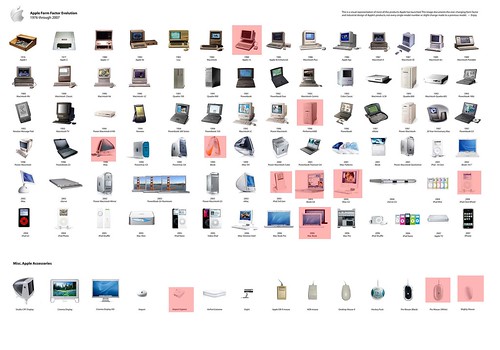
Image by Adam Kuban
Edwin Tofslie created this visual. On his site, he says, "A visual I created to show the evolution of most all Apple products created over the past 30 years. This was created to show the evolution of the form factor and industrial design of the products, not to show every single model or upgrade Apple has launched."
I grabbed it and thought I'd use it to make a history of my Apple purchases. From left to right, top to bottom:
The Apple ][c I must have gotten this in 1985 or '86 (when I was 10 or 11). I remember wanting this computer *so bad* after using the Apple ][e in grade school. I remember going to the Apple dealer (er, excuse me, the Apple authorized reseller) in Olathe, Kansas—The Bottom Line—and drooling over the computers there. I was an overweight kid, so my parents made me a deal: Lose X many pounds, and they would buy the computer. I lost a little weight, but not the specified amount. Still, I think my parents were swayed by my argument that it was an educational tool and an investment in my future. I learned to type on this machine, using a program with a little wizard who did magic according to how well you did. I also discovered Zork (never did finish) and Wishbringer (finished, 'cause it was easier). A couple years later, I got into the Bard's Tale series. This was supposed to be a "portable" computer, hence the "c" for "compact." The machine itself had a handle on the back that folded down to prop up the computer or folded away into the body. You could carry the computer around, but the monitor was one heavy summbitch. Consequently, it never left the living room, where it sat on the desk toward the back of the room. I loved this little machine! I used it until about 9th grade (1989) and then didn't do much with computers at all in high school. By the time I got another computer, see below, they had (OMG!) something new called a hard drive. Hmm...
Macintosh Performa 6220CD: OK, the one pictured here is from the Performa series. I had a 6220CD, which was a pizza-box configuration. My parents helped me buy it, and we got it from Best Buy, of all places. Best Buy! Can you believe that? That was in, oh, 1995, maybe '96, during the dark Gil Amelio years. Anyway, at that time, I think Apple had a glut of products, and the 6220CD was one of the machines Apple made for the casual market—hence the Best Buy thing. It had a 75 MHz PowerPC 603 processor, 16 MB of RAM, a 1 GB hard drive, and a TV/Video card. It came with a little remote, and you could run cable or a broadcast antenna into the thing.
I got this either during my junior year or first senior year of college (I had two senior years because I switched majors), after I discovered the internet in the auxiliary computer center in Strong Hall at KU. I remember bringing this thing home and having one of my roommates kinda freak out a little bit—"Oh man, Adam. I can't believe there's a computer in our house." He wasn't excited; he was a bit disdainful. At the time, he was kind of a hippie in a very minor way, and I think he saw computers as something evil. Sometimes, I think he was right; but mostly, I love computers. That roommate now is totally into computers and has a pretty nice top-of-the-line Powerbook.
Anyway, I got on the internet and thought it was the coolest thing ever! "Oh my god! You can look up Beastie Boys trivia on the web! This is *so* cool!" I discovered MUDs and MOOs with this machine and made my first webpage that probably had a URL like cc.ukans.edu/falcon/~tomodell. Tomodell was my username (self-chosen) and was after my old high-school history teacher, Tom O'Dell.
In May 1997, I brought this machine with me to Oregon, where I used it to keep in touch with friends back in Kansas and in Japan. It was on this machine that I created a short-lived collaborative humor site (now defunct) called lusciousjackass.com and also had a sort of short-lived group blog that some friends and I did. They'd send me emails, and I'd sit there in the common space of our loft, drinking PBR, and post them in reverse chronological order. I also took out the domain www.hatchback.net/ in '98 and have had it since.
This was also the machine that I created the proto version of Slice on. It was originally going to be a photocopied 'zine, and I laid out the mock-up pages in QuarkXPress on this computer.
iMac Rev B: After convincing my parents to buy an iMac Rev A, I liked theirs so much I bought the Rev B. This must have been in late '98 or so. I don't remember doing anything remarkable on this machine. I replaced it rather quickly with an ...
iBook (clamshell, in Tangerine): I bought this one in 2000, shortly before moving to New York City. I didn't want to lug the iMac cross-country, and I left it with my girlfriend at the time, who didn't have a computer. She used it so we could keep in touch as we tried the whole long-distance dating thing. That didn't work out, and the iMac made its way out east. I sold the iMac on eBay and continued to use the iBook. I remember doing freelance copy-editing on it in my Bay Ridge apartment, sitting on an inflatable mattress because I had no furniture and couldn't afford to buy any. Later, when I got a crappy chair from IKEA, I would sit and work at this lame console table–cum-desk that the previous tenant left in the apartment. I kept this this machine until 2003, when I bought my ...
iBook G3: I bought this one in late August or early September of 2003, shortly before creating Slice. I didn't buy it to build Slice, though. I bought it because I had recently gotten cable broadband and wanted a new machine that took full advantage of the fast connection! Little did I know I was getting a piece of shit. I got the last of the G3 Dual USB iBooks, the ones with the faulty logic board problem. I still own it, and it's on its fourth logic board(!!!!) and second hard drive. Apple was good enough to replace all my logic boards for free under a special program, but I had to eat the cost of a new HD for it. I'm letting a friend borrow this computer right now.
I have a certain fondness for this machine, as it fostered the creation of Slice and A Hamburger Today. It's been to San Francisco, where it left its cold machine heart; Kansas; Florida; the Jersey Shore; and Amsterdam, where it visited the Red Light District and picked up a virus (just kidding). It also has a cool In-N-Out sticker on it. I used it until February 2005, when its first hard drive crashed. After four logic boards, I gave up and bought an ...
iMac G5 (17-inch): Unfortunately, this was the first generation of the flat-screen stand iMacs, and it had a problem: excessive fan noise. This machine worked like a dream at first, but after a firmware update pretty early on, the HD cooling fan started running at top speed under the lightest of processor loads. Because of a lame fan design, the thing sounds like a DustBuster. It is highly unpleasant to work in front of for any length of time. I appreciated the large screen and the speed, but when it came time for me to visit Kansas for Christmas 2005, I had the iBook G3's HD repaired and went back to using it. But the iBook G3 was getting mighty sluggish, so it was great when I joined Serious Eats in October 2006 and the company provided me with a ...
MacBook 1.83 GHz Intel Core 2 Duo: I'm typing this history on this machine now. It's loaded with 2GB of RAM and a 160GB hard drive—basically, it's maxed out. It's been a good little machine, except the white keyboard and casing get dirty. I would have liked the black MacBook, but the advisers setting us up with machines said they cost extra, so my boss, Ed, and I both got white machines. This one is missing the cool In-N-Out sticker, mostly because I don't want to gum up company property.
That's it for the Apple computers. But I also purchased ...
iPod 3rd Generation: Actually, my dad bought this one for me when he came to visit. (Thanks, Dad!) This is the one with the four buttons at top and fixed touch wheel. It worked well and I even developed "piPod" for it, a little set of files that rested in the Notes folder that told you where to get good pizza in NYC. That little "app" brought Slice a lot of attention. This iPod served me well until the day I was visiting my friend Janice, sitting up on her apartment rooftop on a weak chair. The leg broke, and I fell, cracking the LCD display. The pod still worked—I just couldn't see what it was playing. I got by for a while, then did without, then bought a ...
iPod Photo (60GB): This was the top-of-the-line iPod for, oh, about 2 months. Then the damn iPod video model came out. Ugh! Apple made such a big deal about how, with mine, they were all going to have color screens!!! Woo-dee-fucking-doo. They were probably just trying to get rid of all their small color screens before switching to the video iPod. Anyway, this is my iPod today. I haven't upgraded to video iPod or the iPhone—yet. I'm sure I'll move to the iPhone one day, but not until after the first generation. I've learned my lesson.
And, I forgot the peripherals! ...
Pro Mouse (White): Purchased pretty soon after it became available, to make laptop computing easier when using my iBook G3 at home. This mouse served me fine until the Mighty Mouse came out.
Mighty Mouse: I was lured by the 360° scroll wheel. The scroll wheel worked like a charm while it lasted. Unfortunately, it gums up with dirt pretty easily, and despite the suggested cleaning routine, mine never started working again. I liked the added two-button feature (finally, Apple! Took you fucking long enough to bow your head and admit that MS had something here). But it didn't work well. It never really did sense when I was applying pressure to the left or right sides of the mouse. I replaced it with a non-Apple product. A Microsoft Intellimouse. My MS mouse is AWESOME.
Airport Express: Works like magic! I love being wireless anywhere in my apartment and out in my garden on nice days. I like that I can stream music to my stereo. I only wish it could stream regular non-iTunes sound to the stereo as well.
Claire says I should now "add up all the money [I've] given to Steve Jobs throughout the years," but I just can't. I don't remember the retail price of some of these machines, plus, I'd be too depressed :(
[July 19]
UPDATE (In honor of Steve's leaving Apple) - 8/25/2011
Since I first posted this -- my most popular image on Flickr by a landslide -- I have used/owned even more Apple products...
Macbook Mid-2010: Intel Mobile Core 2 Duo, 2.4Ghz, 4GB RAM I can't remember exactly when I started using this one. It was probably shortly before or after my wedding. I think I had been complaining loud enough at Serious Eats about my previous MacBook's slowness and crashiness. One day a shipment of new laptops showed up and I got one. This machine served fairly faithfully and well but did get a bit slow before I finally left Serious Eats in May 2011. I've always had the experience that Macs work very well for a while but then seem to begin to slow down. Maybe because I gum them up with too much crap. Anyway, I turned this computer back in to the company on leaving and bought myself a ...
MacBook Air 11-inch, 1.6Ghz/4GB RAM/156GB SSD: The smallest MacBook Air maxed out on processor, RAM, and solid state drive. This machine is beautiful. When I look back at my old iBook, I can't believe the same company made both these machines -- or that that iBook itself was considered great design at one point. Frankly, I don't know how Apple can improve on the aesthetics of the current MacBook Air line. I suppose in minor ways, but as is, it seems almost perfect. So far, fingers crossed, I've had no problems with this machine. It's a little sluggish editing RAW photos, but that's to be expected. I bought it knowing I wouldn't be able to do HARDCORE photo- or video-editing. And that's fine. That's about all I need for the blogging I do these days.
iPod Nano, 3rd generation: I don't even remember why I bought this. At some point my iPod Photo must have died. I don't even remember how or why or what I did with its carcass. I loved the size and format of this Nano -- it's the squat one with the color screen. Before they switched back to the long, narrow stick. I still have it but don't use it. That's because in August 2009 I finally broke down and bought an ...
iPhone 3Gs: And, holy crap, did it change my life. For the better, for the worse. I love having all the information a truly smart smartphone provides at my fingertips. But I do have to admit that I am addicted to it. I'm not even making light there. I truly have a hard time not futzing with the device. I know it's rude to do so during dinner with my wife or out at the bar with friends, but I cannot help it. That is how it has changed my life for the worse. For the better, I absolutely love the GPS navigation app I downloaded for it, which I can't imagine driving without again. And I like being able to look up restaurant advice on the go. At some point, I got caught in the rain with this one, and that began its demise. I killed it the rest of the way by leaving it on the windowsill in the shower and then forgetting about it while turning on the water. (I was listening to NPR while trimming my beard in front of the grooming mirror in the shower ... then stepped out to put the trimmer away and clean up the tub before turning on the faucet... D'OH!) ... Even that didn't kill this iPhone dead, though. I was able to do the rice trick and revive it, but it slowly deteriorated until it started shutting off and asking for full restores. After restoring it 7 times in 2 days, it died.... NEXT!
iPhone 4, 16GB: Even though I had the 32GB 3Gs, I stepped it down to the 16GB for my current (8/24/2011) iPhone. It wasn't worth the extra money for the extra memory. I hadn't maxed out my previous iPhone anyway. LOVE the Retina display and the massively improved camera on this one. Other than that, not much of a difference over the 3Gs.
Thanks, Steve Jobs, for designing all these amazing products. Even though I have had some issues with some of them, they are beautiful, elegant machines that are intuitive and a pleasure to work with. I can't imagine having to use the alternatives (er, actually I can, because I use a shitastic PC at work).
Mike Baird in PFD. Three-Day Kayak and Hiking Tour of the Channel Islands (San Miguel, Santa Rosa, Santa Cruz)
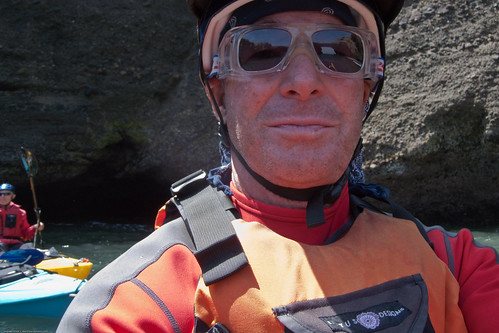
Image by mikebaird
Another snapshot for my Mother who likes to get AmazingMail photo cards from me every week . Mike Baird in PFD. Three-Day Kayak and Hiking Tour of the Channel Islands (San Miguel, Santa Rosa, Santa Cruz - see www.nps.gov/chis/ ) in Southern California, 02-04 July 2009. Five of us from the Morro Bay, CA kayakmorrobay Yahoo! Group (Mike Baird, Steve Cohen, Rouvaishyana, Betty Tegner, Ron Gabel) joined eight others on a Truthaquatics (Santa Barbara, CA - see truthaquatics.com ) adventure outing that may have been the best vacation I've ever taken. Leaving Santa Barbara harbor at 4AM, we arrived at San Miguel Island's Cuyler Harbor, opposite beautiful Prince Island, and hiked to Harris Point on San Miguel the first day, July 2, 2009, under the leadership and interpretation of the most affable and knowledgeable Sabine Faulhaber, a volunteer for the Channel Islands National Park Service, who is a German University of California Materials Dept. graduate student who had just finished her degree. Endemic plant life and many Chumash archeological sites abounded. Remnants of the Chumash civilization can still be seen in thousands of “shell middens” on the island. San Miguel Island is the only known place in the world where 4 different species of seals and sea lions breed and up to 6 species can be found. Also on Day one, July 2, 2009, we paddled a few caves near our Santa Miguel harbor mooring. On Day two in the morning, July 3, 2009, we paddled caves, arches, coves, and beaches along Santa Rosa Island near Bechers Bay and Torrey Pines. That afternoon, we paddled Santa Cruz Island, including the legendary Painted Cave, one of the largest and deepest sea caves in the world. Painted Cave, is on the northwest coastline of Santa Cruz, and is so named because of its colorful rock types, lichens, and algaes. Painted Cave is a quarter-mile long and 100 feet wide, with an entrance ceiling of 160 feet. It was within the halls of this "cathedral" created by nature's raw power of wind and water that I experienced what could only be called a religious experience while listening to the amazing voice of Rouvaishyana sing opera and perform a chant in Hebrew, lighting up the chamber's darkness with pure emotion, which brought tears to my eyes for the joy for being alive and present amidst such magnificence. That evening we made an unscheduled turbulent round-trip back to Santa Barbara to replace a burned out water pump that disabled the generator required for operation of the boat. On Day three, July 4, 2009, by now very confident in our equipment and abilities, we paddled a number of caves and arches in turbulent surf amongst wash rocks and swells. We returned to Santa Barbara late afternoon on July 4th, 2009. Thanks to Rouvaishyana for arranging such a magnificent experience. I have taken the liberty to add some comments made by Rouvaishyana after the trip: "San Miguel Island was a real treat. As you know, I had been expecting foggy, windy weather so it was a treat to hike across the sunny, yet eerily barren plains with great views of the ocean all around. A late-afternoon paddle was the perfect way to end our first day. The long coastal paddle at Santa Rosa Island was perfect for all of us. Lots of exploring, long-distance cruising, thousands of sea lions, and a bald eagle to top it off! It's great that the captain saw fit to trust us to our own strengths and abilities. I knew we could do it. The afternoon paddle at Santa Cruz was even more challenging in some ways, with the need to travel into a 15-knot headwind, though not even for half an hour. Painted Cave was the grand prize, the realization of more than 10 years of dreaming, and only a real storm would have kept me from making it there. Sea caves have long held a mystique for me, and for many people, representing the unknown, entrances into the innards of the earth, places of unique rock formations and hidden life, and even as sacred places. Painted Cave is the greatest and deepest of them all in the ocean world. What a privilege to explore it with others by kayak, and it was just as gratifying that Betty and Sabine, our naturalist, were able to come by Zodiac after being turned back by winds. I didn't mind the unplanned return trip to Santa Barbara, and I found the motion of the sea to be an aid to sleep and relaxation. This was especially true the following morning, when we went back to the east end of Santa Cruz Island. We became an elite group of paddlers when the captain dropped us off at Potato Harbor, announcing that he didn't recommend that day's paddle to anyone except experienced sea kayakers, which we all are. By the way, I learned from reading that Ron is correct about the rocks in that harbor being volcanic. Santa Cruz Island in general is underlain by a layer of basalt and agglomerate volcanic rocks, with shale and other sedimentary rocks on top. The sea cave explorations that day were wonderful, and the clear water an inspiration."
Planning the booth ~ 3 of 3 photos

Image by Urban Woodswalker
Show preparation in progress. Location: my living room 1.5 days before the show.
Table cloth will be added, more rearranging to be done, and product inventory added for sale. Its a good thing I bought 2 6 foot tables when they were on sale...as this one goes back...its damaged right out of the box.
Don't forget the chairs, sunscreen, food and water, sales receipt book, and a healthy happy helper if possible. I also will be crafting on site...so more tools and supplies will be added. And the bags, business cards...price tags...on and on it goes.
No, I do not have enough inventory (which is ALWAYS the rant of every person doing these events)...but I figure, this is my first street fair, and only my second show ever. I will make the best and learn what I can, and have a great time of it regardless of the bottom line. I am amped for a great weekend! Part of it is making contacts, and networking and handing out business cards. Its not just about sales anyways.
FINIS
Culture, Tourism and the Self: Travels in name and space

Image by timtak
Yuji Nakanishi, professor of Tourism at Rikkyou University, points out that “Japanese tend to associate tourism with historical landmarks, but foreigners are interested in people’s lives and their lifestyles,” he said. “Places like the fish market were never really considered a tourist site until quite recently, so both sides are really confused (Tanikawa, 2009).”
"A shop owner told me in an interview: ‘Tourists from China and Japan: here in the morning full of them, but they arrive, five minutes, and run away; they have their own schedule, take a picture and hurry; they don’t stay longer; they have ten minutes to see the church, twenty to see the museum, ten to go in another place.’ These tourists are seemingly not interested in cultural heritage but in collecting the icons of that culture." (Parmeggiani et al., 2010, p110)
Japanese tourists do different things. How should we make sense of them?
Summary
Japanese travel to places for symbols where they themselves provide the sights from the imagination or bodily via auto-photography, whereas Western tourists go places for sights which they interpret and narrate in their thoughts and words. The purpose in each case, of going all that way to experience otherness, is to return to an experience of self undiluted by other.
A few days ago in the village near our beach house, a rainy day, a group of Japanese tourists went from community centre to Buddhist temple, to road side shrine, collecting stamps as part of one of those uniquely Japanese "stamp rallies." No one came to the beach in front of our house. The panoramic view of inland sea, with gulls and fishing boats and its setting sun was of no interest to them. Likewise, this jaded old Westerner can not think of a more boring, more pointless tourism experience than a traipsing around a grey landscape collecting the blotchy red imprints left by a set of rubber stamps.
As Urry (2002) famously argues, Western tourism is about going to see something. This form of tourism has a very long tradition. The picture above left is from a stained glass window in Canterbury Cathedral, England (Wells, 2002, p127, Crown Copyright NMR), the destination of Medieval Christian pilgrimage. Wells, and more famously the anthropologist Victor Turner (Turner & Turner, 1995) have argued that there is a visual bias to Christian pilgrimage, or that the destination of Christian pilgrimage is a located image, such as stained glass, a sacred image or icon.
That the Japanese word for tourism, Kankou is often glossed as "seeing the sights" persuades us that Japanese tourist too are interested in going to see. In fact the would "Kankou" originates n the Tao-Te-Ching which argues that rulers should travel to other countries so as to gain information on how better to rule their own. The passage which introduces the word "kankou" is a recommendation not to travellers but to hosts to " indicate (shiimesu) the (high)lights of your country." Even on a literal reading, "Kankou" (Japanese tourism) is about going to places where things are explained (note 0).
The stamp rally has its origins in the proof of visitation required of Japanese pilgrims during the Tokugawa period (Graburn, 1983; Reader, 2005), but before that Japanese accumulated pieces of paper stamped with sacred symbols for more than one thousand years. The religious act of Shinto, far more than prayer, is a form of pilgrimage, shrine-visiting, mairi or moude, a movement of the worshipper. And at the shrine, before amulets and sacred stamped pieces of card were distributed symbols: first branches of trees and stones, later stamped pieces of paper. The destinations provided the names. The destinations were the named places, the "meisho". But did Japanese pilgrimage destinations provide the sights?
Not only in the stamp rally but in many forms of Japanese tourism is the sight strangely eschewed. I can remember my disappointment when taken to the the ancient seat of regional government at Dazaifu to find only an empty field. Japanese tourists visit castle towns, such as the most famous, Hagi, where there is NO CASTLE TO BE SEEN! They visit ruins ('of identity' see Hudson, 1999; Plutschow, 1981) such as that visited by Matsuo Basho, where there is NOTHING to be SEEN at all. Hudson, citing Plutschow (1981, p22) argues that, "Basho' choice of ato (ruin) was itself derived from the medieval Japanese tradition of travel diaries, wherein the significance of a place was determined by its history - its location in time, rather than by geography."
Traditionally shrines, the destination Japanese par excellence contained a prototypical meibutsu, the God-body (goshintai) of the shrine that might be a mirror, sword, jewel, or sacred stone but it was *forbidden to see this item*. The goshintai was situated symbolically . It was wrapped up in layer upon layer of cloth, box, inner shrine, out shrine and shrine walls (Hendry, 1995; Pilgrim, 1986; Bachnik & Quinn, 1994) partly to ensure that it was never seen at all. Shrines have the structure of an onion. The visitor may never become aware that there is anything at their centre, other than the fact that the visitor knows that something is there, symbolically. After all, shrines are the prototypical, great and famous, named place (meisho).
According to an informant, a Japanese tour guide, the vast majority of Japanese tourists visiting Ise Shrine today, visit the woods around the shrine, see at most its outer walls, and the souvenir shop, and the car park. Japanese tourists have thronged to Ise for centuries (especially inspired by stories of sacred symbols falling from the sky (fudaori), but without special appointment they do not see the shrine itself, much less the holy of hollies, the mirror of the sun goddess, the goshintai, prototypical named-thing (meibutsu) at its centre. Even those that do have special dispensation to enter the outer walls of Ise Shrine will be faced with that which Guichard-Anguis (2007) describes as the biggest difference between pilgrimage to Ise compared with that in Europe; the shrine building itself will have been rebuilt within the last twenty years. Even though Japanese are noted for their fondness of historical attractions, not only do they go to visit empty sites or 'ruins', the Japanese rebuild even the old sites and buildings anew. This is not just in the case of Ise Shrine but also in the case of Japanese homes, and Castles such as Osaka castle, as bewailed by XYZ.
The fact that sights are not so important as named significance may also explain the lack of attention to the maintenance of visual "authenticity," even in places such as Tokyo. Tomomitsu-Tomasson (2005) a research student in sociology, expresses her disappointment at arriving in Kyoto with a quote from Kerr's damning portrait of the dark side of Japan (2002).
“How must Kyoto appear to one who has never visited here? Passersby clad in kimono going to and fro along quiet narrow streets between temples, rows of houses with black wooden lattices, glimpsed over tiled roofs the mountains covered with cherry blossoms, streams trickling at one’s feet….the traveler’s expectations must be high – until the moment when he alights from the Bullet train. He leaves the station, catches his first sight of Kyoto Tower, and from there on it is all shattered dreams. Kyoto Hotel cuts off the view of the Higashiyama hills, and big signs on cheap clothing stores hide Mount Daimonji.Red; vending machines are lined up in front of the temples. It’s the same miserable scenery you see everywhere in Japan, and the same people oblivious to it all” (Professor Tayama Reishi direct quote) (Kerr 2001:164/65). in Tomomitsu-Tomasson (2005), p 4.
In my new home town of Yamaguchi I have written about how sad it is that less is done to maintain traditional urban architecture such as in Tatekouji Street, since it is this type of sight, that is the essence of a tourist attraction and destination. That Japanese are happy to visit Kyoto and Yamaguchi without demanding visual authenticity is again a result of their relative lack of interest in the visual dimension of tourist destinations.
Finally, it just seems to me that the Japanese are not so interested in views. The fact that I continue to live in an more recently purchases house with excellent views, or that I have a panoramic view from the window where I now write drives this home. I feel considerable empathy with the words of the Blondie song, "All I want is a room with a view," and seek to live in places which command a view. In Japan, however it is said that "high places attract smoke and stupid people," and while the high places may be elevated social positions, I think that it may also apply to the more literal interpretation. Perhaps part of my preference for views is my stupid desire to look down on things and other people.
Why do Japanese go to these symbolically significant named-places places, rather to interpret visual sites?
It seems to me that the answer can be found in theories of the Western, and Japanese self.
Here I should have a long introduction to (cross cultural psychology)
Origins in Triandis' Hofestede' collectivism
Markus and Kitayama turn around
Heine rejection of the need for self regard
Oyserman/Takano/Yamagishi attacks on collectivism
Hong YY and more so, Nisbett/Masuda cognitive turn
Kim and Non-Linguistic thought, and in her second paper on that topic on self expression, the non-linguistic self
And then ask what, phenomenologically is the self in the West and Japan like? What is it like to have an independent self? What is felt to be self? What is felt to be not self? How can one have a "interdependent self" what does hat feel like? What phenomena are felt to be self in that situation?
And then me (ha!)
For the Westerner, the self is the self narrative. Tourists of the MacCannelian or Cullerian kind visit and play ethnographer or semiologist (MacCannell, 1976; Culler, 1988) regarding the sights that they see. The Western tourists provides the narrative because they are narrative and the sight is the otherness which they attempt to interpret. To these tourists the things that they see are signs but they are signs which have the structure of an alibi (Culler, 1988; Barthes,1972), signing off to a meaning which the tourist, in their phonetic inner narrative, provides. The Western tourists may take of photo of the sight, or better still purchase a photo upon the reverse of which she will narrate herself in this location. The Western tourist goes to see and say. Like ethnologists or anthropologists they use the phenomenological technique of bracketing away preconceptions (the more other unusual, opaque to the interpretations that they have to hand that a sight is the more that task is performed for them) and then they make pronouncement upon the sights that they see. This transcendental meditation employed by Western Anthropologists and Tourists alike, can be described in the following way,
From this new transcendental standpoint Husserl maintained that the manifold stream of contingent world-objects could be perceived in a new way, giving 'a new kind of experience: transcendental experience'. The transcendental ego because a 'disinterested onlooker' whose only motive is neutrally to describe 'what he sees, purely as seen, as what is seen and seen in such and such a manner' (Rayment-Pickard, 2003)
Japanese tourists on the other hand do not go to provide symbols about sights, but to provide sights or images regarding symbolic locations. The symbolic sites visited by Japanese tourists, the named places, the named things, do not have the structure of the alibi (see Hansen, 1993) but are the signs themselves. That Japanese tourists go to places with literary, historical, named significant, that they vistic symbolic geographies as been ascribed (as all things Japanese always are) to their "groupism," and also, in the face of Westernisation, to their nostalgic desire to return to their historical routes, to their self. This latter interpretation hits the mark I think because the Japanese self is a space (Kanjin; Hamaguchi, 1997) , a primordial space (Nishida 1993; Watsuji 1979; see Mochizuki, 2006) a mirror (Kurozumi). When the self is a space, then the concept of travel presents inherent difficulties. How can space travel? I argue that the Japanese tourists' interest in historical, literary, or otherwise famous named-places, and named-things is because it is not the place but the name that they are visiting. The Japanese travel to places precisely because they are "encrusted with renown," (Culler); and are all the more happy if as at shrines, or ruins, their is nothing to see because it is in the space of their mind that they provide the images to go with the otherness of the symbols that they are visiting. Indeed in a sense they do see that holy of holies, the mirror of the sun goddess in the internal space that is the Japanese mind.
Lacan argues that the self is at the presumed intersection of linguistic self signification -self narration, and visual self reflection, mirrorings and imagingings. Neither the symbolic nor the imaginary can say or see itself. The word can not enunciate the enunciated even in time since it is always delayed, defered (Derrida, 1998), never the person that it was what the attempt was started. Husserl's "living present" is always already gone. Likewise, the minds eye is unable to see itself. It requires the admixture of an other, the image of oneself, the name of oneself for each to enable the self to wrap around upon itself and self itself into self hood. This admixture is to be kept to a minimum. The self image in the West is external, when identified a sign of vanity or 'narcissism'. The word or symbol in Japan is external, and when internalised an impurity of mind (See Kim, 2002).
In either case, these essential impurities or 'supplements,' which are both required to complete and are additional to self(Derrida, 1998) are washed away in the experience of tourism when the Western and Japanese tourist meets the other as image or symbol respectively. The transcendental meditation for the Japanese tourist, at the British Museum, at the Named Place ruin of a famous castle, at the walls of Ise Shrine, becomes a interested visualiser of the place hidden in time, behind those walls. Souzou ga fukuramu. Images spring to mind. And even as the "Kankou" they shut their eyes to the world (Hitomi wo Tojiru) and call to mind the glory of the place they are visiting and in that experience, see themselves as the visual space, place or soul, that they believe themselves to be.
If either the Western tourist leaves something of himself it narratival. He signs a guest book. He narrates himself on a postcard (postcards are not sold for writing upon in Japan but only as packs, as symbolic souvenirs).
The Japanese tourist on the other hand provides the images, not just in her own mind, but also in the form of auto-photography so central to the tourism experience in Japan.
These differences have important implications for the tourist industries catering to Western and Japanese tourists.
When serving Japanese tourists it is important to provide the names, the narrative the guidebooks (which Japanese tourists themselves prepare in relative abundance), the words. They must also be provided the opportunity to provide images: above all to to imagine, and also to photograph themselves. Tourist destinations that do not have words related to them (iware no nai) are not of interest. Japanese tourist travel all the way to the lake district in the North of England, ignoring the beauty of the Powys hills completely, because the former have no literature - no words associated with them. They avoid the markets of London concentrating on the British museum and tower since the latter are redolent with renown. Japanese tourism providers need to counter the ocular turn of contemporary tourism theory and as the Japanese policy paper at the start of the ”tourism-oriented country" advocates a return to the original meaning of Kankou, or rather the provision of Kankou, which is not merely in the gaze directed, but in the of indication of facts, of nominal, symbolic entities.
"When promoting tourism it is therefore essential to return to this [etymological] origin of tourism, and create revolution in the very notion of tourism. The origin of tourism is not just looking at famous places and scenery, or seeing the sights, in regard to the the things that the local population feel happy about, to the things that the inhabitants of a certain land feel proud of and "indicating these highlights." (note 1)
Those especially in Japan however, who are catering to Western tourists should be aware that a place does not need to have a name for the Western tourist to want to visit it. In fact it helps if (other than the "markers" to find it) the destination is un-named "authentic" since the Western visitor provides the words. He is the words that he provides. These ethnographic, phenomenological tourists want to narrate, pronounce, theorise (what I am now doing) about the things that they see and in so doing they (I make myself shiver) have a transcendental experience of who they are, the words that drift across the universe of 'exterior' visual phenomena. Give us a view, any view, something to speak about, a picture and postcard, a picture postcard, above all give us something to see and some means by which they can narrate and we will be happy. There are such opportunities in every Japanese village not only the famous ones. Western tourist go to see spaces and places, and there is (or should be) much more for them to see. Alas at present, or until recently, the Japanese presume that their visitors are also Japanese and "indicate the highlights" (Kankou) or show the Named-places only. Very recently, there is a trend to promote regional tourism resources which do not have a name, this geographical tourism (shock!) had to be given a neologism "jitabi," since the very concept of simply going to see a place was alien to the Japanese.
Finally the above theoretical position resolves the problem how tourists can be going in search of authenticity (MacCannell, 1986) even in blatantly inauthentic "post tourism" (Urry, 2002) sites: on tour we bring ourselves to confront the other of the self, we find our self in maximal authenticity.
Bibliography created using Zotero
Bachnik, J. M., & Quinn, C. J. (Eds.). (1994). Situated Meaning: Inside and Outside in Japanese Self, Society, and Language. Princeton University Press.
Barthes, R. (1972). Mythologies. (A. Lavers, Trans.). Farrar, Straus and Giroux.
Culler, J. D. (1988). Framing the sign. Univ. of Oklahoma Pr.
Derrida, J. (1998). Of grammatology. JHU Press.
Rayment-Pickard, H. (2003). Impossible God: Derrida’s theology. Ashgate Publishing, Ltd.
Graburn, N. H. H. (1983). To pray, pay and play: the cultural structure of Japanese domestic tourism. Université de droit, d’économie et des sciences, Centre des hautes études touristiques.
Guichard-Anguis, S. (2009). The Culture of Travel (tabi no bunka) and Japanese Tourism. In A. Guichard-Anguis, O. Moon, & M. R. del Alisal (Eds.), Japanese Tourism and Travel Culture (1st ed., pp. 1–18). Routledge.
Kerr, A. (2002). Dogs and Demons: Tales from the Dark Side of Japan. Hill and Wang.
Hamaguchi, E. 恵俊浜口. (1982). 間人主義の社会日本(The Japanese Society of Spatial-Personism my trans). 東洋経済新報社.
Hansen, C. (1993). Chinese Ideographs and Western Ideas. The Journal of Asian Studies, 52(02), 373–399. doi:10.2307/2059652
Hendry, J. (1995). Wrapping Culture: Politeness, Presentation, and Power in Japan and Other Societies. Oxford University Press, USA.
Hudson, M. (1999). Ruins of identity: ethnogenesis in the Japanese Islands. University of Hawaii Press.
Kim, H. (2002). We talk, therefore we think? A cultural analysis of the effect of talking on thinking. Journal of Personality and Social Psychology.
MacCannell, D. (1976). The tourist: A new theory of the leisure class. Univ of California Pr.
Mach, E. (1897). Contributions to the Analysis of the Sensations. (C. M. Williams, Trans.). The Open court publishing company. Retrieved from www.archive.org/details/contributionsto00machgoog
Ministry of Land Infrastructure, Transport and Tourism. (2003) "Creating a Country which is Good to Live in and Good to Visit." www.kantei.go.jp/jp/singi/kanko/kettei/030424/houkoku.html#I
Mochizuki, T. (2006). Climate and Ethics: Ethical Implications of Watsuji Tetsuro’s Concepts:‘ Climate’ and‘ Climaticity’. Philosophia Osaka, 1, 43–55. Retrieved from ir.library.osaka-u.ac.jp/metadb/up/LIBPHILOO/po_01_043.pdf
Nakashima, Y. 中島義道. (1997). 「対話」のない社会―思いやりと優しさが圧殺するもの (A Society without Dialogue; Things Suppressed by Sensitivity and Kindness. My Trans). PHP研究所.
Nishida, K. (1993). Last Writings: Nothingness and the Religious Worldview. University of Hawaii Press.
Tanikawa, M. (2009, April 7). In Kyoto, a Call to Not Trample the Geisha. The New York Times. Retrieved from www.nytimes.com/2009/04/07/world/asia/07iht-geisha.html
Parmeggiani, P., Burns, P. M., Lester, J. M., Bibbings, L., & others. (2010). Integrating multiple research methods: a visual sociology approach to Venice. Tourism and visual culture, Volume 2: Methods and cases, 94–110.
Pilgrim, R. B. (1986). Intervals (‘ Ma’) in Space and Time: Foundations for a Religio-Aesthetic Paradigm in Japan. History of Religions, 25(3), 255–277.
Plutschow, H. (1981). Four Japanese Travel Diaries of the Middle Ages. Cornell Univ East Asia Program.
Reader, I. (2005). Making pilgrimages: Meaning and practice in Shikoku. University of Hawaii Press.
Suda, K. 寛須田. (2005). 産業観光読本. 交通新聞社.
Turner, V., & Turner, E. (1995). Image and Pilgrimage in Christian Culture (0 ed.). Columbia University Press.
Urry, J. (2002). The Tourist Gaze. SAGE.
Tomomitsu-Tomasson, J. (2005). Furusato and Theme Parks: Cultural Authenticity and Domestic Tourism. Furusato and Theme Parks: Cultural Authenticity and Domestic Tourism. Unpublished essay submitted for coursework: The Tourist Gaze, Department of Sociology, Lancaster University. Retrieved April 15, 2012, from www.lancs.ac.uk/postgrad/tomomits/authenticity.pdf
Watsuji, T. 和辻哲郎. (1979). 風土―人間学的考察 (Climate: Human Observation. My Trans.). 岩波書店.
Wells, E. J. (2011). Making ‘Sense’ of the Pilgrimage Experience of the Medieval Church. Peregrinations Journal, III(2), 122–146. Retrieved from peregrinations.kenyon.edu/vol3_2/raw_materials/Wells/Pere...
Wittgenstein, L. (1973). Philosophical Investigations (3rd ed.). Prentice Hall.
note o
「易経」の「観国之光利用賓于王」(「国の光を観しめす(みるとも読む)、もって王の賓たるに用いるによろし」と読む)、すなわち「国」とは、当時の中国の状況からみてひとつの地域を表し「光」とは、地域のすぐれたものないし特色を意味するとされる。
The [relevant passage] of the Tao Te Ching reads "*Indicating* [Shimesu, Kanagmiru] the lights of the country are good to use as hospitality for a king". where country mean the localities of contemporary China, and "lights" [highlights] refer to the superior or special things of that locality. (my translation, my emphasis, and my comments in brackets).
note 1
観光立国の推進に当たっては、まずはこうした「観光の原点」に立ち返ること、つまり「観光」概念の革新が必要になる。観光の原点は、ただ単に名所や風景などの「光を見る」ことだけではなく、一つの地域に住む人々がその地に住むことに誇りをもつことができ、幸せを感じられることによって、その地域が「光を示す」ことにある。 「国の光を観る」 −観光の原点−
note 2
I think that the primordial space of the Japanese self (Nishida's ba), or the "climate" (Wasuji's fudo) can best be understood from a Western perspective as the "Field of Vision" (Mach, 1897). The visual field pictured in Mach's self portrait is usually seen, if existing at all, as being a form of barrier ("veil" "tain" or "hymen") between self and the world. To the Japanese this field, this primordial space, however, is the pure experience of self (Nishida, Zen no kenkyuu), as self-inseparable-from-spatial-other. This Japanese self is however separate from the world of symbols but, Japanese need the admixture of symbol, the name, their own name, for the Japanese child to believe that the their body houses this ephemeral mirror. In Japan it is precisely the linguistic which is public (Nakashima, 1997) and space, place and vision which as private as it gets. Taking a balanced view, neither images nor language are more private than the other, both requiring an other to have meaning, but it took Westerners almost two millenia to realise that language is meaningless if private (Wittgenstein, 1973).
You spent how much for Valentines' Day?

Image by elycefeliz
Wishing all flickr friends the best on Valentines' Day - at no monetary cost - : }
Americans will spend .6 billion this year for Valentine's Day.
According to the survey, the average person who celebrates Valentine’s Day will spend 6. Men are doing most of the spending - 9 on average. The survey said women are spending dollars.
51 percent of people who celebrate will buy candy.
36 percent will buy flowers.
36 percent will take someone out on an evening date.
19 percent will give someone jewelry.
13 percent will give a gift card as a present.
The NRF polled more than 9,000 lovebirds and found that the average person planned to spend on their spouse or significant other, up from last year. Additionally, shoppers were expected to shell out an average of .25 on their children, parents or other family members; .92 on their friends; and .52 on their pets.
That's right: their pets. According to a separate survey of 6,000 pet owners, conducted by Petplan pet insurance, 78% said they'd spend money on Valentine's Day treats for their furry friends. About 62% of pet parents said they'd drop up to ; 27%, as much as ; and 11%, even more.
And it's not only retailers and pets who are expected to see a boost this week. Another surprising group that routinely enjoys a bit of a windfall around Valentine's Day?
Divorce lawyers.
Divorce filings rise about 40% this time of year, says data from Avvo, a site that rates and ranks lawyers. And lawyers are capitalizing on the trend. One firm in West Virginia, for example, attracts potential clients by announcing a contest to give away a free divorce. Unhappy spouses in the state need only visit Webb Law's website and fill out a form – the person with the most compelling reason for needing a free divorce, wins
Detail from frieze around door





